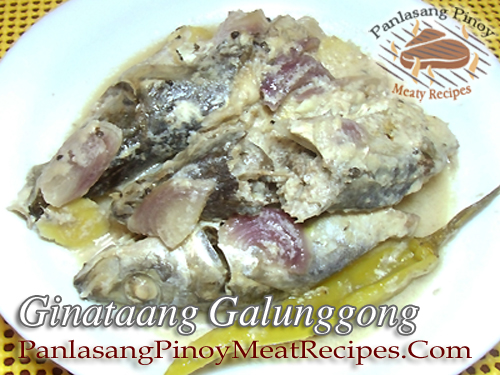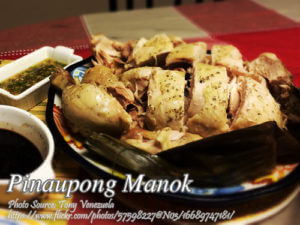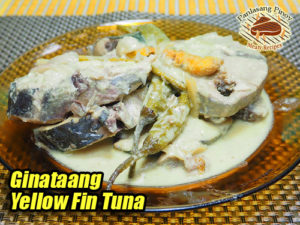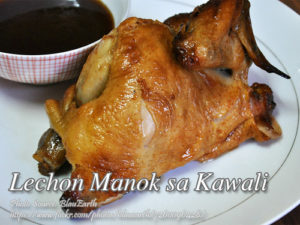This recipe is scad fish in coconut milk or ginataang galunggong cooked in vinegar and coconut milk. There are ways of cooking it in a pot. Either you can use stainless steel pot which is recommended rather than using aluminum or iron pot because it may affect the taste due to the vinegar. But using a claypot is much better because it will give you a distinctive taste specially if you will line the bottom of the pot with wilted banana leaves to prevent burning the fish.
A Taste of Home with Ginataang Galunggong
Growing up, nothing quite warmed my heart like the aroma of ginataang galunggong simmering on the stovetop. My Lola Maria, who grew up in the coastal town of Batangas, used to make this dish at least once a week. She’d tell us stories of how she learned it from her own mother, who would cook it over a wood fire by the seaside, letting the salty breeze and fragrant coconut milk fill the air. Galunggong, or scad fish, may be small and unassuming, but in Filipino homes, it’s truly a beloved staple that packs a flavorful punch, especially when simmered in rich coconut milk.
This ginataang galunggong recipe is humble yet so delicious. The tender, flavorful fish paired with creamy coconut milk and a hint of tangy vinegar creates a balance of flavors that’s hard to beat. Every time I cook this dish, I’m reminded of my family’s deep-rooted love for simple yet satisfying meals.
Choosing the Right Pot for Authentic Flavor
One thing my Tito Jose taught me was that choosing the right pot makes a difference in cooking ginataang galunggong. In our family, we prefer using a clay pot, or palayok, for this recipe. It might seem like a small detail, but it adds a distinctive, earthy flavor that stainless steel or aluminum pots just can’t provide. If you don’t have a clay pot, a stainless steel pot works well too. However, we avoid using aluminum or iron pots as they can react with the vinegar and affect the taste.
When using a clay pot, I learned a little secret from my Tita Nida: lining the bottom with banana leaves. Not only does this prevent the fish from sticking or burning, but it also infuses a subtle aroma that brings a nostalgic, tropical twist to the dish. I always smile remembering my cousin, Lito, joking that it tasted like a “mini-vacation” on each plate.
Prepping Galunggong for the Best Flavor
Before starting, it’s essential to clean the galunggong well, especially if you’re buying them fresh from the market. Rinse thoroughly, and make sure the fish is scaled and gutted. My Lola would always remind me that a clean fish means a clean taste. She believed in the importance of prep work, something that she said was “the foundation of any good dish.”
Once the fish is ready, arrange it in a single layer in a shallow pan. My family likes to keep the fish intact for better presentation and to ensure each piece absorbs the vinegar and coconut milk flavors evenly.
Cooking Techniques for the Perfect Ginataang Galunggong
One of the unique techniques in cooking ginataang galunggong is to add the vinegar right at the beginning and let it simmer before introducing the coconut milk. My uncle Ramon, who is a bit of a cooking enthusiast, explained to me that adding vinegar first helps tone down any fishy smell while locking in the fish’s natural juices. Plus, vinegar is a key ingredient that gives this dish its slight tang, balancing the richness of the coconut milk later on.
As the fish begins to simmer with the vinegar, salt, ginger, black pepper, and a touch of vetsin (or MSG, if you like), let it cook for a few minutes without stirring. This is crucial to avoid breaking up the fish pieces and keeps the flavors concentrated. Once it’s ready, pour in the coconut cream, and here’s another tip I learned from my aunt: stir very gently to prevent curdling.
When the mixture starts to boil, lower the heat, cover the pot, and let it simmer for about 10 minutes. The slow cooking allows the sauce to thicken beautifully, creating a creamy, slightly tangy sauce that complements the galunggong perfectly.
The History and Heart of Ginataang Galunggong
Ginataang galunggong may not have the fame of dishes like adobo or sinigang, but it holds a special place in the hearts of many Filipinos. The use of coconut milk, or gata, reflects the bounty of the islands, particularly in the Visayas and Mindanao, where coconut trees are abundant. Galunggong, often dubbed the “poor man’s fish,” is affordable and accessible, yet it transforms into something remarkable when combined with the right ingredients.
In my family, the dish was often served during rainy days, bringing warmth and comfort to everyone at the table. My mom would sometimes add chili for a touch of spice, while my dad preferred it with more ginger for that extra zing. It’s a versatile dish that can be adjusted to suit different tastes, and it has become a true representation of Filipino resilience and creativity in the kitchen.
Serving Suggestions and a Final Touch
Once the ginataang galunggong is ready, serve it hot with a bowl of steamed rice. There’s something magical about the combination of creamy coconut sauce and fluffy white rice that just hits the spot. In my family, we like to drizzle a bit of the sauce over the rice to savor every last drop.
This dish may be simple, but it’s filled with memories of family gatherings, laughter, and love. Whether you’re a beginner or an experienced cook, I encourage you to give ginataang galunggong a try. Just a taste, and you’ll be transported to the Philippines, experiencing the warmth and flavors of a true Filipino kitchen.
How to Cook Ginataang Galunggong (Scad Fish in Coconut Milk)
Ingredients
- 1/2 kilo fresh galunggong medium sized
- 1/2 cup vinegar
- 1/4 cup water
- 2 pcs long green chili (siling haba) long
- 1 tsp. salt or to taste
- 1 tsp. vetsin or MSG
- 1 Tbsp. ginger minced
- 1 and 1/2 cup coconut cream thick
Instructions
How to cook Ginataang Galunggong
- Clean galunggong, arrange in a shallow pan.
- Add salt, vinegar, water, pepper, ginger and vetsin.
- Boil, do not stir. Cook for 5 minutes. Add coconut cream.
- Stir gently so the cream would not curdle.
- When it boils, cover and lower heat.
- Cook for 10 minutes and until sauce thickens.
Notes
Cooking Tips:
Use Fresh Coconut Milk for Richer Flavor
While canned coconut milk is convenient, using fresh coconut milk makes a huge difference in flavor and texture. Fresh coconut milk is creamier and more fragrant, enhancing the richness of the dish. If possible, squeeze your own from grated coconut or buy it freshly pressed from the market.Cook Without Stirring After Adding Coconut Milk
Once you add the coconut milk, avoid stirring too much to prevent the sauce from curdling. Let the fish simmer gently so that the sauce thickens naturally and coats the fish evenly. Stirring too vigorously can break up the fish and cause the coconut milk to separate.Add Banana Leaves for an Earthy Aroma
Lining the bottom of your pot with wilted banana leaves not only prevents the fish from sticking but also infuses the dish with a subtle earthy flavor. The leaves protect the fish from direct heat, allowing it to cook gently. This technique also adds a traditional touch that elevates the dish’s overall experience.





